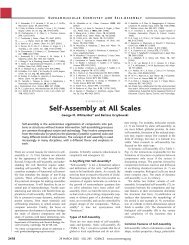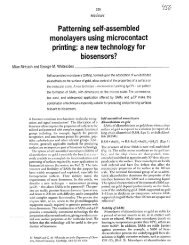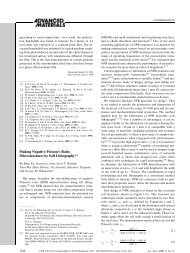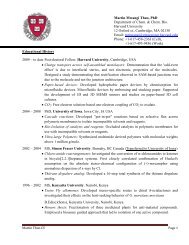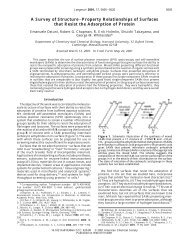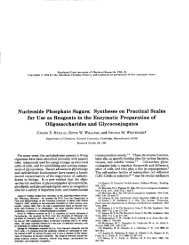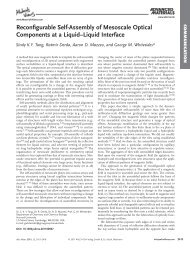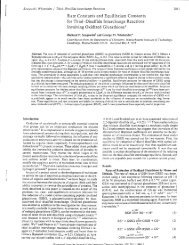Self-Assembled Monolayers of Thiolates on Metals as - Whitesides ...
Self-Assembled Monolayers of Thiolates on Metals as - Whitesides ...
Self-Assembled Monolayers of Thiolates on Metals as - Whitesides ...
Create successful ePaper yourself
Turn your PDF publications into a flip-book with our unique Google optimized e-Paper software.
1132 Chemical Reviews, 2005, Vol. 105, No. 4 Love et al.<br />
that the m<strong>on</strong>olayer is not well packed al<strong>on</strong>g the outer<br />
edge.<br />
6.3.1. Spectroscopic Evidence for SAM Structure <strong>on</strong><br />
Nanoparticles<br />
Spectroscopy (IR and NMR) provides informati<strong>on</strong><br />
about the c<strong>on</strong>formati<strong>on</strong> and packing <str<strong>on</strong>g>of</str<strong>on</strong>g> the alkyl<br />
chains <strong>on</strong> the nanoparticles. 166,168,170,171,467,476,477 A<br />
solid-state IR study <str<strong>on</strong>g>of</str<strong>on</strong>g> the structure <str<strong>on</strong>g>of</str<strong>on</strong>g> SAMs <str<strong>on</strong>g>of</str<strong>on</strong>g><br />
n-alkanethiolates <strong>on</strong> 1-2 nm gold clusters showed<br />
that the major difference between planar SAMs and<br />
SAMs <strong>on</strong> nanoparticles is that the SAMs <strong>on</strong> nanoparticles<br />
exhibit a higher number (10-25%) <str<strong>on</strong>g>of</str<strong>on</strong>g> chain<br />
end-gauche defects (for all chain lengths) than SAMs<br />
<strong>on</strong> planar substrates. 171 The same study found that<br />
SAMs <strong>on</strong> nanoparticles have a number <str<strong>on</strong>g>of</str<strong>on</strong>g> nearsurface<br />
and internal kink defects similar to that <str<strong>on</strong>g>of</str<strong>on</strong>g><br />
planar SAMs formed from alkanethiols <str<strong>on</strong>g>of</str<strong>on</strong>g> similar<br />
lengths. IR spectra <str<strong>on</strong>g>of</str<strong>on</strong>g> the same nanoparticles in<br />
carb<strong>on</strong> tetrachloride show a degree <str<strong>on</strong>g>of</str<strong>on</strong>g> disorder comparable<br />
to that <str<strong>on</strong>g>of</str<strong>on</strong>g> liquid n-alkanes. 470 One interpretati<strong>on</strong><br />
<str<strong>on</strong>g>of</str<strong>on</strong>g> the difference in IR spectra between soluti<strong>on</strong><br />
and the solid ph<strong>as</strong>e is that the packing <str<strong>on</strong>g>of</str<strong>on</strong>g> the<br />
nanoparticles in the solid state induces some degree<br />
<str<strong>on</strong>g>of</str<strong>on</strong>g> order <strong>on</strong> the alkanethiolates. Alternatively, the<br />
solvati<strong>on</strong> <str<strong>on</strong>g>of</str<strong>on</strong>g> the alkyl chains by carb<strong>on</strong> tetrachloride<br />
could account for the observed disorder.<br />
As the size <str<strong>on</strong>g>of</str<strong>on</strong>g> the particle incre<strong>as</strong>es, the properties<br />
<str<strong>on</strong>g>of</str<strong>on</strong>g> the SAM become more similar to a SAM <strong>on</strong> a<br />
planar surface: particles with a core diameter greater<br />
than 4.4 nm, coated with a SAM <str<strong>on</strong>g>of</str<strong>on</strong>g> dodecanethiolates,<br />
have spectroscopic and physical properties approximating<br />
that <str<strong>on</strong>g>of</str<strong>on</strong>g> a planar SAM. 166 For 4.4 nm particles<br />
the majority <str<strong>on</strong>g>of</str<strong>on</strong>g> the surface comprises flat {111}<br />
terraces rather than edges and corners; this geometry<br />
leads to “bundles” <str<strong>on</strong>g>of</str<strong>on</strong>g> ordered alkanethiolates with<br />
gaps (are<strong>as</strong> with a disordered organic layer) at the<br />
corners and vertexes (Figure 9b). 170,472,473 These<br />
“bundles” have been hypothesized to play an important<br />
role in the solid-state packing <str<strong>on</strong>g>of</str<strong>on</strong>g> nanoparticles<br />
into lattices (see secti<strong>on</strong> 6.4).<br />
6.3.2. Evidence for the Structure <str<strong>on</strong>g>of</str<strong>on</strong>g> SAMs <strong>on</strong><br />
Nanoparticles b<strong>as</strong>ed <strong>on</strong> Chemical Reactivity<br />
The chemical reactivities, both <str<strong>on</strong>g>of</str<strong>on</strong>g> the metal core<br />
and the alkanethiolate ligands, have been used to<br />
evaluate the structure <str<strong>on</strong>g>of</str<strong>on</strong>g> SAMs <strong>on</strong> nanoparticles. For<br />
example, Murray and co-workers studied the kinetics<br />
and thermodynamics <str<strong>on</strong>g>of</str<strong>on</strong>g> the displacement <str<strong>on</strong>g>of</str<strong>on</strong>g> <strong>on</strong>e<br />
alkanethiolate for another <strong>on</strong> the surfaces <str<strong>on</strong>g>of</str<strong>on</strong>g> gold<br />
nanoparticles (2 nm diameter) <strong>as</strong> a functi<strong>on</strong> <str<strong>on</strong>g>of</str<strong>on</strong>g> chain<br />
length. 446,459,478 They find that the alkanethiolates<br />
bound to the vertexes and edges have a higher rate<br />
<str<strong>on</strong>g>of</str<strong>on</strong>g> exchange than those in the dense, well-packed<br />
planar faces. The rate <str<strong>on</strong>g>of</str<strong>on</strong>g> exchange decre<strong>as</strong>es <strong>as</strong> the<br />
chain length and/or steric bulk <str<strong>on</strong>g>of</str<strong>on</strong>g> the initial SAM<br />
incre<strong>as</strong>es.<br />
The susceptibility <str<strong>on</strong>g>of</str<strong>on</strong>g> differently protected gold cores<br />
to a cyanide etchant gives an indicati<strong>on</strong> <str<strong>on</strong>g>of</str<strong>on</strong>g> the density<br />
<str<strong>on</strong>g>of</str<strong>on</strong>g> packing <str<strong>on</strong>g>of</str<strong>on</strong>g> the alkanethiolates in the SAM (secti<strong>on</strong><br />
8.1). 470,476,479 For nanoparticles, the rate <str<strong>on</strong>g>of</str<strong>on</strong>g> dissoluti<strong>on</strong><br />
(etching) decre<strong>as</strong>es with incre<strong>as</strong>ing chain length; the<br />
rate remains c<strong>on</strong>stant when the chain length is<br />
greater than 10 carb<strong>on</strong>s, however. 470 This result<br />
complements the spectroscopic evidence, which in-<br />
dicates an ordered inner core with incre<strong>as</strong>ed fluidity<br />
<str<strong>on</strong>g>of</str<strong>on</strong>g> the carb<strong>on</strong> chains in the outer shell. 170<br />
<str<strong>on</strong>g>M<strong>on</strong>olayers</str<strong>on</strong>g> <strong>on</strong> nanoparticles composed <str<strong>on</strong>g>of</str<strong>on</strong>g> branched<br />
alkane chains <str<strong>on</strong>g>of</str<strong>on</strong>g>fer a higher degree <str<strong>on</strong>g>of</str<strong>on</strong>g> protecti<strong>on</strong> to<br />
chemical etching (sodium cyanide) than do straight<br />
chain alkanes. 470,476 Murray and co-workers found<br />
that SAMs formed from 2-butanethiol decre<strong>as</strong>ed the<br />
rate <str<strong>on</strong>g>of</str<strong>on</strong>g> etching by NaCN to the same degree that<br />
hexanethiol did. 470 In a related study, Rotello and coworkers<br />
formed SAMs from alkanethiols functi<strong>on</strong>alized<br />
with a variety <str<strong>on</strong>g>of</str<strong>on</strong>g> amides and esters with branched<br />
end groups and evaluated the stability <str<strong>on</strong>g>of</str<strong>on</strong>g> the m<strong>on</strong>olayer-protected<br />
clusters using cyanide etching and IR<br />
spectroscopy. 476 They hypothesized that “c<strong>on</strong>e-shaped”,<br />
branched molecules would more effectively occupy the<br />
volume available at the outer edge <str<strong>on</strong>g>of</str<strong>on</strong>g> the m<strong>on</strong>olayer<br />
than simple n-alkanethiolates, which have a linear<br />
geometry when extended in an all-trans c<strong>on</strong>formati<strong>on</strong><br />
(Figure 9).<br />
The chemical reactivities <str<strong>on</strong>g>of</str<strong>on</strong>g> terminal functi<strong>on</strong>al<br />
groups displayed <strong>on</strong> SAMs formed <strong>on</strong> the surfaces <str<strong>on</strong>g>of</str<strong>on</strong>g><br />
nanoparticles are different than those <strong>on</strong> SAMs <strong>on</strong><br />
planar surfaces. For example, Murray and co-workers<br />
dem<strong>on</strong>strated that SN2 reacti<strong>on</strong>s occur more readily<br />
<strong>on</strong> the surfaces <str<strong>on</strong>g>of</str<strong>on</strong>g> nanoparticles than <strong>on</strong> planar<br />
surfaces. 470 The headgroups <str<strong>on</strong>g>of</str<strong>on</strong>g> ω-bromoalkanethiolates<br />
are less densely packed <strong>on</strong> curved surfaces<br />
than they are <strong>on</strong> planar surfaces; this lower density<br />
allows backside attack <str<strong>on</strong>g>of</str<strong>on</strong>g> the incoming nucleophile<br />
(amine) to occur. The rate is a functi<strong>on</strong> <str<strong>on</strong>g>of</str<strong>on</strong>g> the steric<br />
bulk <str<strong>on</strong>g>of</str<strong>on</strong>g> the incoming amine <strong>as</strong> well <strong>as</strong> <str<strong>on</strong>g>of</str<strong>on</strong>g> the relative<br />
chain lengths <str<strong>on</strong>g>of</str<strong>on</strong>g> the bromoalkanethiolates and the<br />
surrounding alkanethiolates. The me<strong>as</strong>ured rates are<br />
similar to soluti<strong>on</strong>-ph<strong>as</strong>e rates for SN2 substituti<strong>on</strong>s,<br />
in agreement with the spectroscopic data (secti<strong>on</strong><br />
6.3.1) regarding the fluidity <str<strong>on</strong>g>of</str<strong>on</strong>g> the SAMs <strong>on</strong> nanoparticles.<br />
6.4. SAMs and the Packing <str<strong>on</strong>g>of</str<strong>on</strong>g> Nanocrystals into<br />
Superlattices<br />
The same surfactants that are used to c<strong>on</strong>trol the<br />
size and shape <str<strong>on</strong>g>of</str<strong>on</strong>g> nanocrystals also influence the<br />
organizati<strong>on</strong> <str<strong>on</strong>g>of</str<strong>on</strong>g> the particles into superlattices and<br />
colloidal crystals. 480-483 In colloidal crystals the nanoparticles<br />
are sometimes referred to <strong>as</strong> “molecules”<br />
and the van der Waals c<strong>on</strong>tact <str<strong>on</strong>g>of</str<strong>on</strong>g> surfactant layers<br />
<strong>on</strong> neighboring particles <strong>as</strong> intermolecular “b<strong>on</strong>ds”. 54<br />
When spherical nanocrystals, protected by a layer <str<strong>on</strong>g>of</str<strong>on</strong>g><br />
alkanethiolates, are allowed to self-<strong>as</strong>semble <strong>on</strong> a<br />
TEM grid via slow evaporati<strong>on</strong> <str<strong>on</strong>g>of</str<strong>on</strong>g> solvent, they form<br />
hexag<strong>on</strong>al close-packed 2-D arrays (Figure 10). 483-486<br />
Preparati<strong>on</strong>s with shorter alkyl chains (hexanethiol)<br />
<strong>as</strong>semble in soluti<strong>on</strong> to form ordered 3-D, colloidal<br />
crystals. 486 The separati<strong>on</strong> <str<strong>on</strong>g>of</str<strong>on</strong>g> the close-packed spheres<br />
is linearly dependent <strong>on</strong> the length <str<strong>on</strong>g>of</str<strong>on</strong>g> the alkyl chains<br />
(Figure 10b). 486,487 The incre<strong>as</strong>e in particle spacing<br />
per additi<strong>on</strong>al carb<strong>on</strong> (∼1.2 Å) is about <strong>on</strong>e-half <str<strong>on</strong>g>of</str<strong>on</strong>g><br />
the expected value; this observati<strong>on</strong> suggests that the<br />
alkyl chains might interdigitate with the chains <strong>on</strong><br />
neighboring particles. 81,482,486,488 There are also examples<br />
<str<strong>on</strong>g>of</str<strong>on</strong>g> hydrogen-b<strong>on</strong>ding c<strong>on</strong>trol over interparticle<br />
spacing for gold nanoparticles with carboxylic-acidterminated<br />
SAMs. 447,489<br />
Nanocrystals with other morphologies <strong>as</strong>semble,<br />
promoted by the hydrophobic tails <str<strong>on</strong>g>of</str<strong>on</strong>g> the capping




